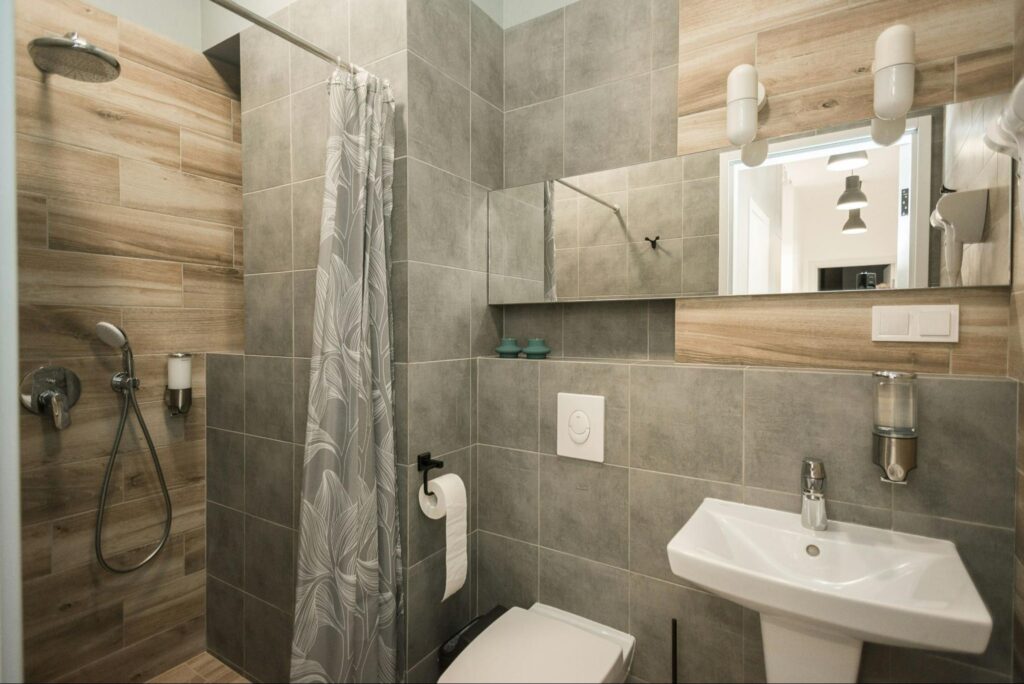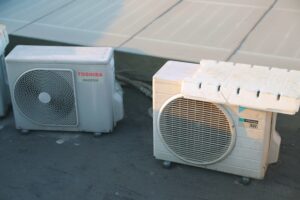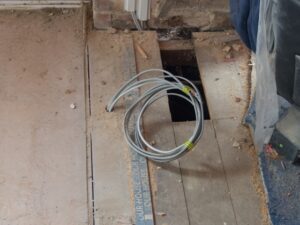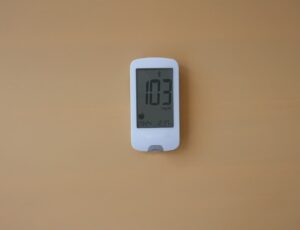Choosing the right size for an on-demand water heater isn’t just about picking a unit and hoping for the best. It’s about understanding your household’s peak hot water needs, ensuring you don’t waste energy or end up with a system that can’t keep up.
Sounds complicated? Not at all!
Think about it—how many times have you found yourself running the dishwasher, taking a shower, and maybe even doing laundry all at once? It’s easy to forget that each of these appliances pulls from the same hot water supply, which is where sizing your water heater correctly comes into play.
At Excel Mechanical, we understand how important it is to match the right system to your needs. Whether you’re upgrading your current setup or installing a new one, we are here to guide you every step of the way. We take into account your preferences and budget to install a system that’s both efficient and reliable.
With our expert team, you’ll feel confident that the system we provide will meet all your hot water needs—whether for a busy household or your commercial space.
In this blog, we’ll walk you through:
- Understanding how to calculate your peak hot water demand
- The difference between electric and gas-powered on-demand heaters
- Tips for selecting the perfect size to match your lifestyle
Let’s ensure you get the most out of your tankless water heater while saving space and energy.
Ready to find your ideal fit?
Understanding On-Demand Water Heaters
On-demand water heaters, also known as tankless water heaters, heat water only when you need it. This efficiency can save you money on energy bills. Understanding their types and benefits can help you make an informed decision.
Types of On-Demand Water Heaters
There are two main types of on-demand water heaters: electric and gas-powered.
- Electric models are more compact and ideal for smaller homes or apartments. They use electrical heating elements to warm the water and are usually easier to install.
- Gas-powered heaters use a burner to heat water. They typically have a higher flow rate, which can benefit larger households that use more water simultaneously.
When choosing between these options, consider the energy sources available in your home and your household’s hot water needs.
Both types offer unique features that can match different requirements.
Benefits of On-Demand Water Heating
One of the primary benefits of on-demand water heaters is energy efficiency. They only heat water when needed, reducing energy waste. This can lead to lower utility bills over time.
Another advantage is the space-saving design. Without a bulky tank, these units free up room in your home. This can be particularly useful in smaller living spaces.
On-demand water heaters often have a longer lifespan compared to traditional models. This means you won’t need to replace them as often, which can save you money in the long run.
Determining Your Hot Water Needs
To select the right tankless water heater, you must consider household size, usage habits, and peak demand. These elements play a key role in ensuring you always have enough hot water.
Household Size and Usage Patterns
The size of your household and how you use hot water are essential factors.
A small household might only need hot water for a few tasks, like showering and running a dishwasher. Larger households often require more hot water, with multiple showers or appliances running simultaneously.
Knowing your family’s specific needs helps you choose the appropriate heater size. For example, frequent showers, laundry, and dishwasher use all contribute to water usage.
Tracking these patterns helps you tailor your choice to match your day-to-day needs.
We provide expert guidance to help assess these needs. Our team can analyze your household demands to offer the best system for your requirements and budget.
Peak Demand Calculation
Calculating peak demand is vital for determining the size of your water heater.
Peak demand refers to the maximum amount of hot water used at the busiest time. For accurate calculations, you must consider the number of gallons per minute (GPM) required during peak usage.
Add up the flow rates for all fixtures and appliances likely to be used simultaneously. For instance, a shower typically requires 2.5 GPM, and a dishwasher might use 1.5 GPM.
Summing these gives an idea of the maximum GPM your water heater should handle.
Sizing On-Demand Water Heaters
Choosing the right size for an on-demand water heater involves understanding two key factors: your household’s flow rate requirements and the necessary temperature rise.
These factors ensure your system meets your needs without wasting energy or space.
Flow Rate Requirements
To determine the correct size of an on-demand water heater, you need to calculate the flow rate in gallons per minute (GPM). This figure represents how much hot water you need at once.
Start by listing all the fixtures you might use simultaneously, such as showers, faucets, and appliances. Each fixture typically has a standard flow rate. For example, a shower might need 2.5 GPM. Add up the flow rates of all the fixtures that you plan to use at the same time.
Ensure your water heater can handle this combined flow rate.
Temperature Rise Calculation
Temperature rise refers to the difference between your groundwater and desired hot water temperatures.
- First, find your area’s average groundwater temperature. You can find regional charts online or consult with professionals.
- Next, decide the temperature you want your hot water, often around 120°F for most homes.
- Subtract the groundwater temperature from this desired temperature to find your temperature rise.
This calculation helps you choose a water heater that can effectively and efficiently heat your water.
Factors Influencing Water Heater Size
Choosing the right size for your on-demand water heater depends on various factors. Key points to consider include the climate of your location and the energy efficiency you wish to achieve.
Both play a significant role in determining the optimal size that meets your household’s needs.
Climate and Incoming Water Temperature
The climate in your area significantly impacts the size of the water heater required.
- In colder regions, the incoming water temperature is often lower. This means your water heater needs to work harder to raise the water temperature to a comfortable level. For example, if you live where the incoming water temperature is 40°F, the heater must increase it by about 60°F to offer warm water.
- In warmer climates, the incoming water temperature is relatively higher. This means less energy is needed to heat water, potentially allowing for a smaller heater.
Consider using a guide to determine the best size based on your specific climate and water needs.
Efficiency Ratings and Energy Sources
Efficiency ratings are essential when selecting the appropriate size for your water heater.
Heaters with higher efficiency ratings consume less energy, which can lead to significant cost savings over time. Be sure to compare different models’ ratings to understand their efficiency levels.
The energy source—whether electricity, natural gas, or propane—also influences the heater size. Each energy source has different performance characteristics, affecting the efficiency and capacity needed.
At Excel Mechanical, we provide information on choosing the right heater based on energy sources, ensuring you get great value and efficiency tailored to your specific needs. Our team of professionals is dedicated to helping you choose the best option for residential and commercial applications.
Installation Considerations
When installing an on-demand water heater, you need to consider where it will go and what type of fuel it will use. Ensuring proper space and ventilation can affect the unit’s performance and longevity.
Space and Location
Choosing the right spot for your tankless water heater is crucial. These heaters are compact, so they often save space compared to traditional models. Ensure the location allows easy access for maintenance and connections to water lines and power sources.
Consider proximity to the points where hot water is most used, like bathrooms and kitchens. Shorter pipe runs mean quicker hot water delivery and higher efficiency. A secure, stable wall can support the weight and necessary plumbing connections.
Fuel Type and Ventilation
The type of fuel—electricity, natural gas, or propane—will affect installation needs.
Electric units often require different wiring and circuit capabilities. Gas models necessitate adequate ventilation to manage exhaust gases safely.
Proper ventilation is critical for safety and efficiency. It prevents the buildup of harmful gases and can involve venting through a wall or roof.
Local building codes should always be followed to ensure compliance and system safety.
Upfront Costs and Long-Term Savings
When considering an on-demand water heater, you should understand the initial investment and the potential savings over time. These systems often come with higher upfront costs but can offer reduced operating expenses and potential returns on investment in the long run.
Initial Investment
The cost of an on-demand water heater can be higher at the outset compared to traditional tank models. This investment includes not only the price of the unit itself but also installation fees, which might be more due to the need for electrical or gas upgrades.
Despite the higher initial costs, it is essential to consider the benefits, such as saved space and the potential increase in property value.
Operating Costs and ROI
Although the initial costs are higher, on-demand water heaters can save significant energy over time. These units heat water only as needed, decreasing energy usage compared to constantly heating a tank. This efficiency can result in lower utility bills.
The return on investment, or ROI, becomes evident as you save on energy costs. Over several years, these savings can offset the initial expenses. With proper maintenance, these systems often have a longer lifespan than traditional models.
Choosing the Right Model
Picking the correct on-demand water heater involves considering brand reliability and ongoing maintenance needs. Brands vary in quality and the types of warranties, while maintenance requirements can impact long-term convenience and costs.
Brand and Warranty
When selecting a tankless water heater, the brand can significantly influence the unit’s reliability and longevity.
Some brands offer better warranties, protecting you against defects and unexpected failures. A good warranty is not just about the length of coverage but also about what it includes, such as parts and labor.
Excel Mechanical is known for its commitment to quality and customer satisfaction in the HVAC and plumbing sectors. Choosing Excel Mechanical ensures that you receive support tailored to residential and commercial needs, focusing on delivering systems that fit your unique requirements and budget.
Maintenance Requirements
Maintaining an on-demand water heater is essential to ensure efficiency and extend lifespan.
Regular maintenance might include tasks like descaling to prevent mineral buildup and checking the unit’s filters. Some models require more frequent upkeep than others, impacting both time and cost.
Understanding the specific maintenance needs of the model you are considering can help you avoid potential problems and maintain consistent hot water flow.
We prioritize delivering systems that perform efficiently and require manageable maintenance efforts, providing value and reliability to your investment.
Common Misconceptions
When choosing an on-demand water heater, you should understand common misunderstandings. Focus on selecting the appropriate size for your needs and clarify beliefs about endless supply myths.
Size Versus Capacity
A common mistake is confusing the physical size of a tankless water heater with its capacity to deliver hot water. Unlike traditional heaters, tankless models heat water directly. What matters is their flow rate, measured in gallons per minute (GPM).
Selecting the right flow rate based on your household’s needs ensures enough hot water. For example, a typical shower might require 2.5 GPM, while a dishwasher may need 1.5 GPM. Calculating peak usage is crucial to avoid any shortfalls.
Unlimited Hot Water Supply Myths
Many believe tankless heaters provide endless hot water in any situation.
While they can continuously heat water as it flows, they have limits based on their heating capacity. Multiple high-demand appliances running simultaneously can exceed the unit’s ability to provide hot water.
Understanding these limits helps in selecting the right unit. For example, if you run two showers and a dishwasher, your heater must handle that total demand.
Professional Consultation and Self-Assessment
Determining the right size for an on-demand water heater involves two main approaches: consulting with professionals and using online tools.
Hiring a Qualified Technician
Consulting with a qualified technician can provide valuable insights into selecting the right tankless water heater.
A professional can assess your hot water usage and household needs. They consider the number of bathrooms, bedrooms, and appliances that require hot water simultaneously.
Excel Mechanical offers expert HVAC and plumbing services for both residential and commercial properties. Our professionals strive for exceptional quality and great value, ensuring you get the best solution.
A technician can evaluate your requirements and recommend the best water heater size that fits your budget without compromising efficiency.
Online Sizing Tools
Online tools provide a convenient way to estimate the size of a tankless water heater you might need. These tools typically require input, such as the number of bathrooms and appliances using hot water. They may also consider your location’s climate, which affects water inlet temperatures.
Using tools like these lets you get a general idea of your needs before contacting a professional. They are a good starting point for discussions with experts. While online tools are helpful, consulting with a technician remains crucial for a thorough and accurate assessment, ensuring you receive the best system tailored to your specific requirements.
Frequently Asked Questions
Choosing the right size tankless water heater involves considering factors such as the number of bathrooms, household size, and peak water usage needs. A properly sized unit ensures efficient energy use and reliable hot water supply.
How do I calculate the size of the tankless water heater necessary for my home?
Calculate your household’s peak hot water demand in gallons per minute (GPM) to determine the size. Consider the number of bathrooms and appliances using hot water simultaneously. Use this information to select a heater that meets your requirements.
What are the guidelines for sizing a tankless water heater for a family of four?
Most homes will need a unit that provides 7-9 GPM for a family of four. This supports multiple showers and appliances running at the same time without depleting the hot water supply. When choosing the size, it’s essential to consider peak demand periods.
Can a 9.5 GPM tankless water heater accommodate all my household needs?
A 9.5 GPM tankless water heater is generally sufficient for larger households. It can handle multiple showers and appliances like dishwashers and washing machines. This size is ideal if your household frequently uses multiple water fixtures together.
What should I consider when replacing a 40-gallon water heater with a tankless model?
Switching to a tankless model involves assessing hot water demand and adjusting to an on-demand system. Evaluate your peak usage needs and choose a unit that aligns with these. Consider installation changes and potential energy savings.
Is there a recommended size for a tankless water heater for a two-person household?
A unit providing 3-5 GPM usually suffices for two people. This allows for the comfortable use of showers and small appliances without running out of hot water. It’s a compact option that efficiently serves a smaller household.
What factors determine the necessary capacity of a tankless water heater for a certain number of bathrooms?
The number of bathrooms directly affects the required capacity. Consider simultaneous usage scenarios, like having showers and faucets on simultaneously. The demand for each bathroom’s fixtures must be added to calculate the needed capacity for the water heater.




